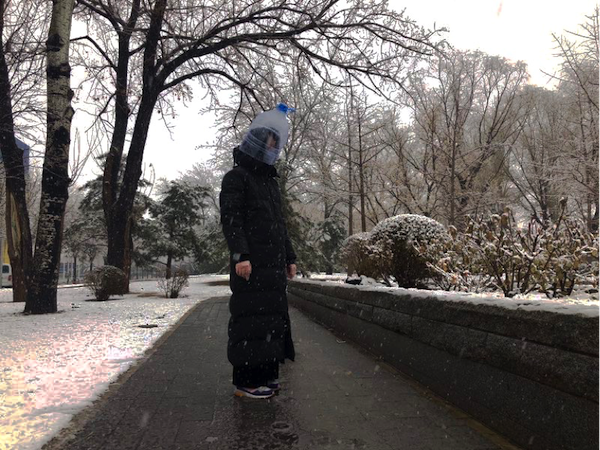Organized by Lawrence Gipe, “Quarantined Visions” is an online exhibition of work created during the COVID-19 pandemic lockdowns. Beginning with images from China, this series will continue from country to country in collaboration with international curators, featuring new work by artists living in countries hit hard by the virus.
In 2019, China was maintaining its status as a major player in the contemporary art scene. The excitement was fueled by the allure and success of international art fairs, taking place mainly in Shanghai, which is the PRC’s most glittering and cosmopolitan city. As long as participating artists kept their political criticism to themselves (which was a major sticking point to some, but by no means all), a vast market of buyers appeared to be waiting – eager to join the ranks of the trendy art cognoscenti.
Then dawn broke on 2020.
The art scene in Beijing is driven by public events: installations, performances, dance, cinema…as these disciplines have gone mute during lockdown, artists have concentrated on photography and mixed media. In many ways, the work of Chinese artists has gone completely underground during the recent pandemic. This first installment of Quarantined Visions includes five artists: each worked during the lockdowns and many had to modify their usual practices given the reality of the moment.

Huo Youfeng, Untitled, 2020, altered vintage photograph
Huo Youfeng’s mixed media works were begun just before, and during, the Corona lockdown. His latest work begins with an historical photographic image, which he obscures under a defiling layer of expressive paint. Youfeng (b. 1965, Heilongjiang, China) lives and works in Beijing where he was first renowned as a printer/lithographer, and influential as a teacher. In the US, he appeared most recently in Studio System 2 at the Torrance Art Museum. His photo manipulation work (here evidenced by a be-masked Leni Riefenstahl image of an Aryan youth) effectively melds two authoritarian layers, the idealized muzzled by a mask that provides both protection and imposed silence and anonymity. For those familiar with the Berlin Wall, and the art images associated with it, the pair famously embracing in “In the End, Isolation” will be recognizable under the masks: Leonid Brezhnev and Erich Honecker, the former chairman of the DDR.

Huo Youfeng, 2020, In the End, Isolation, altered vintage photograph
Youfeng writes: “In Western countries, normally only sick people wear face masks. This is the opposite of the East. The mask reminds people: ‘guard against the virus that could invade you.’ The face mask gives everyone a sense of security, but also a refuge from intrusion. In this way: everyone is equal. Whether it is a virus or racism, an individual or a great power, it is hidden behind non-hierarchically.”

Li Yang, 2020, Street a, digital photo
Li Yang (b, 1983, Beijing) has a career spanning multiple decades and disciplines; he is best known nationally in China as a scene designer for opera and large-scale music events. Obviously, in the COVID-19 environment, all games are off in this profession. He turned to photography while quarantined in Beijing, creating a haunting series depicting the empty city. In his work for the theater, Li Yang is often charged with designing urbanscapes or environments, which for him creates a constant dichotomy between reality and illusion in his practice.

Li Yang, 2020, Street J, digital photo
Wu Mengshi (b, 1986, Zhejiang, China) was educated at CAFA, Central Academy of Fine Arts) an important art Institution and museum in Beijing. Her kinetic works consist of skeins of delicate threads that cling and move nervously across a magnetized surface. Video available on:www.wumengshi.com.

Wu Mengshi, 2020 , Can, mixed media kinetic sculpture

Wu Mengshi, 2020 , Can, mixed media kinetic sculpture
Both Mengshi and Wu Hong (b.1972, Beijing) have long ties to CAFA (Central Academy of Fine Arts), which alongside Tsinghua University, ranks as the most prestigious art academy in Beijing. Hong, who heads the Lithography department at CAFA, recently began this series of mixed media works tackling the issues of incarceration, animal treatment, and – metaphorically – of power itself.

Wu Hong, Caged 1, 2019-2020, ink, paper, security grill

Wu Hong, Caged 2, 2019-2020, ink, paper, security grill
The personal work of Jenny Tang is represented here, by two photographs that relate directly to the quarantine. Normally her métier is lithography, but the crucial equipment is as locked-down as the people. Tang was trained at Tsinghua Academy of Arts and Design, and has exhibited in, and curated for, that institution. Tang writes: “To overcome fear and anxiety, I observe the surroundings with my eyes, and perceive my feelings with my heart.”

Jenny Tang, 2020, Untitled, photograph

Jenny Tang, 2020, Untitled, photograph

